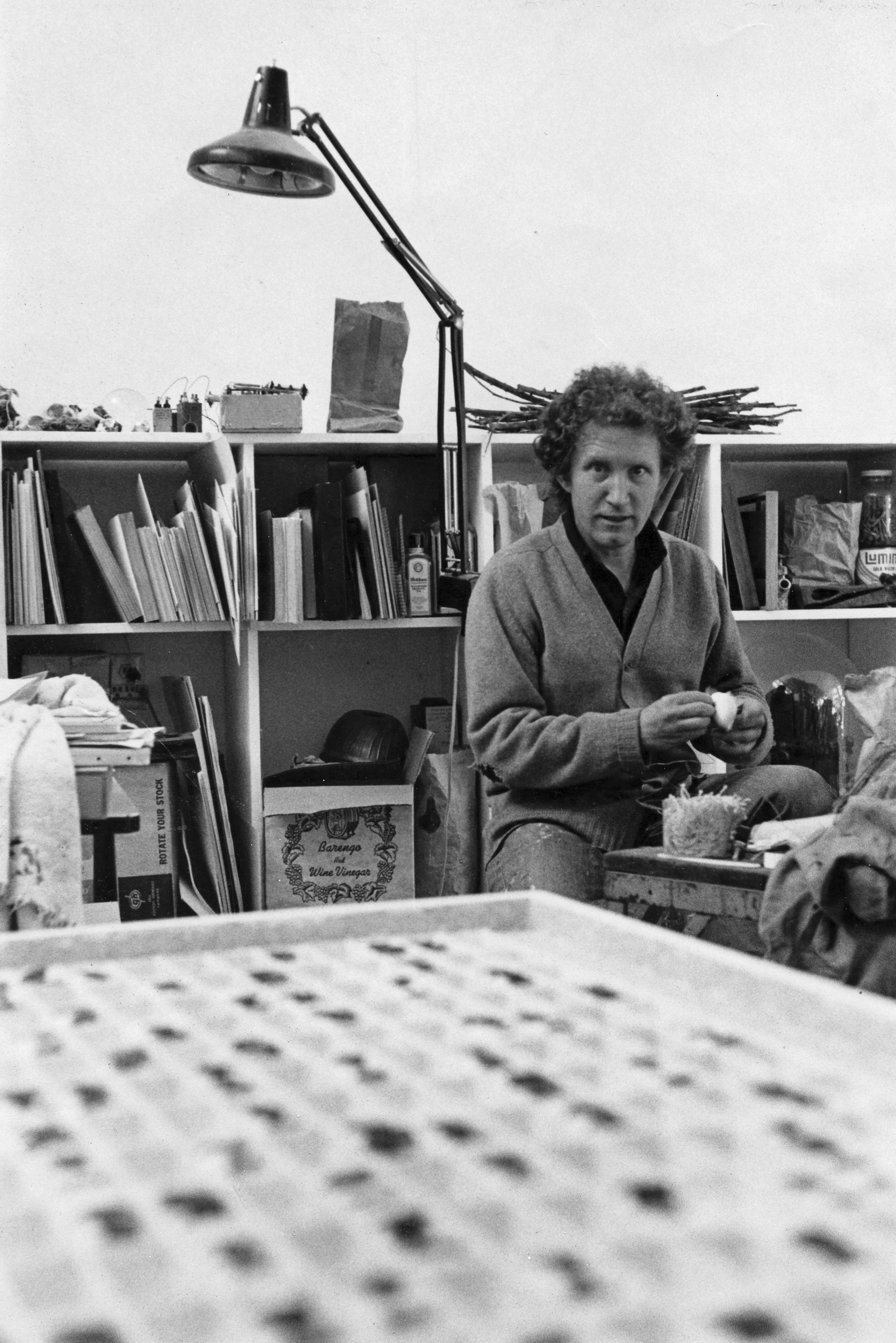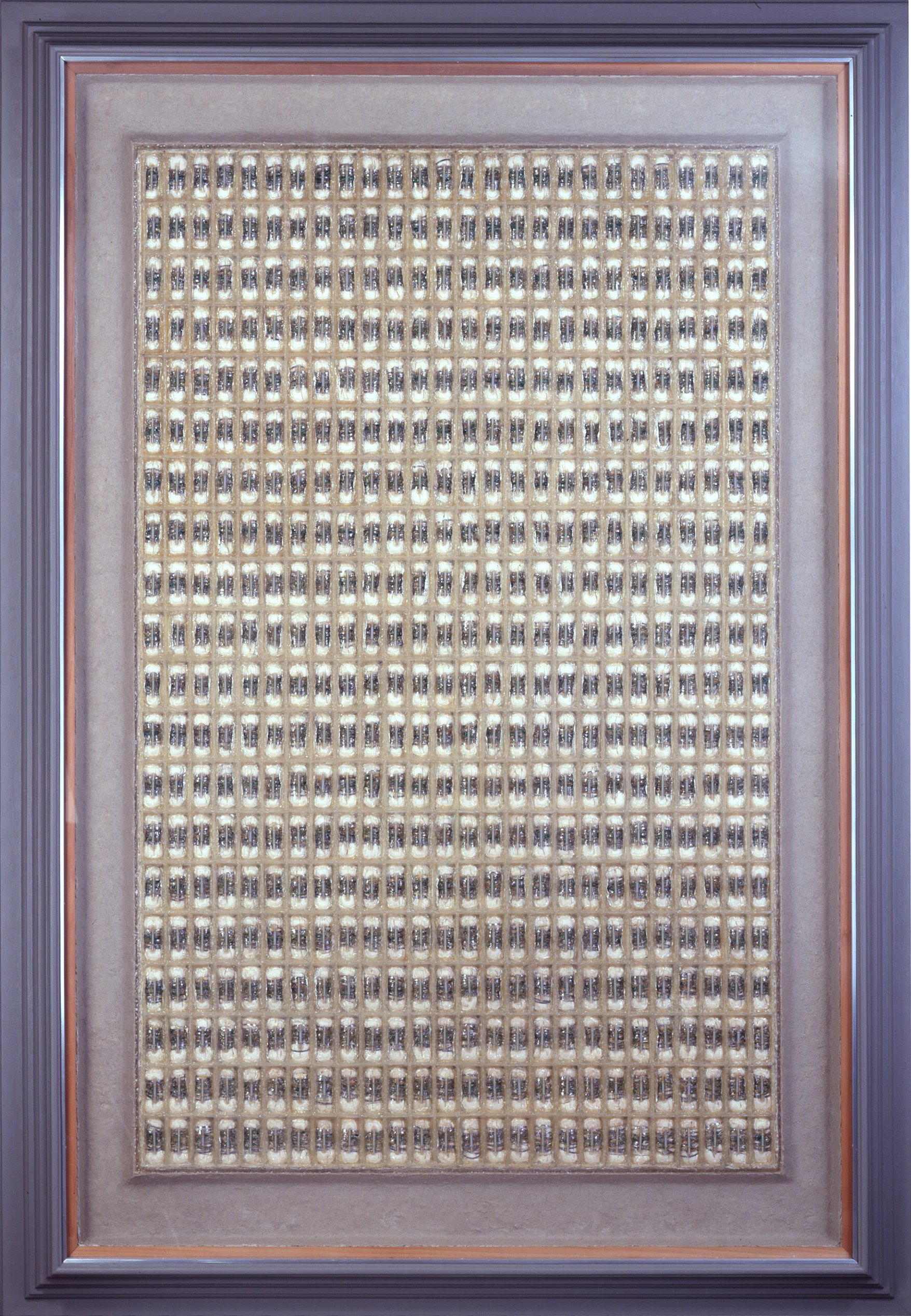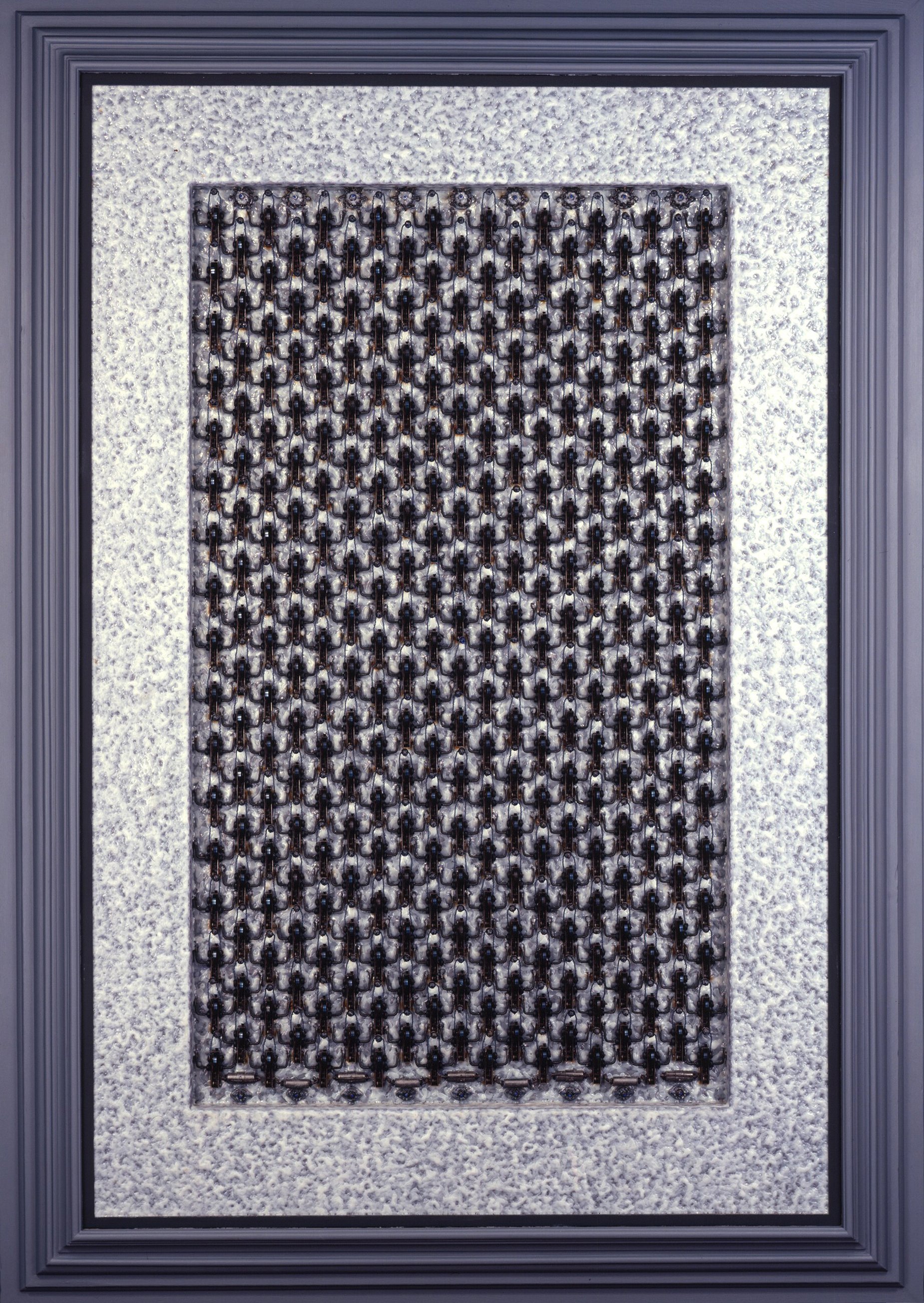Hardy Hanson: There Are Things to Come
April 6- July 10 at Michelle Thomas Fine Art Gallery + Studio
Michelle Thomas Fine Art Gallery is pleased to announce major museum and institutional acquisitions from our Spring 2024 exhibition, Hardy Hanson: There Are Things to Come. Twelve artworks in total were acquired.
The Crocker Museum acquired wall reliefs Take Your Medicine, Nothing Is Too Big to Swallow, 1994-96, Night Sky (Nocturne), 2005, and a selection of Hanson’s lithographs, gift of friend of The Gallery, Seth Ammerman. They will also acquire the wall relief Downpour, 2005 and the sculpture Domestic Architecture,1978, gift of Deborah Bain in memory of Joel Young.
The San Diego Museum of Art acquired Celestial Puzzle, 2006-2007, along with a selection of Hanson’s lithographs.
Fresno Art Museum acquired the wall reliefs Untitled,1990 and Serpent’s Dream, 1988-1990, gift of Deborah Bain in memory of Joel Young.
The Mary Porter Sesnon Galleries at University of California, Santa Cruz acquired the wall relief, Dry Ice, 1979-1980.
ABOUT THE ARTIST
Harold “Hardy” Hardeman Hanson was born in Long Beach, California on February 16, 1935. He lost his mother three weeks after his birth and was raised by his father and older sister. By the age of nine, Hardy started a paper route, which he soon scaled up to a newspaper stand. He expanded his ventures by the time he was twelve, commissioning a cabinet shop to build a shoeshine stand, followed by dozens of entrepreneurial schemes through adolescence. Despite his constant activity, Hardy felt a lack of purpose and direction. Dropping out of high school, he enlisted in the Army and served his term, then embarked on a study of graphic design at Long Beach City College, later shifting his focus to fine art at UCLA and Yale.
Hardy married his wife, Ruth, and in 1961 settled in Santa Monica. Hardy and Ruth shared many interests, including gardening, literature, and politics; the depths of their political expression ignited in the 60s as they supported urgent anti-war and civil rights protests sweeping the city, their children in tow. Hardy began teaching and held positions at UCLA, San Fernando Valley College, and Cal State Northridge. In 1969, the family moved to Santa Cruz, where Hardy began to teach at UCSC.
Hardy taught drawing and painting, utilizing creative strategies fed by his own convictions, intellectual curiosity, and ironic sensibility. Artist Celeste Baross recalls him saying, “We make our world significant by the courage of our questions and the depth and honesty of our answers.” She reflects, “For all his wit, it was not hard to see that Hardy was motivated by high principles and a truly passionate intelligence. What mattered most was what was true, and not what merely makes us feel better.” Discipline, honesty, integrity, and the priority he placed on introspection were the basis of his pedagogy and the touchstones of his creative process.
This synergy spanned six decades of experimentation with color, form, and scale. Hardy explored themes both local and archetypal, using a variety of mediums and techniques: drawing, painting, printmaking, sculpture. He employed found materials to express his perspective of the world and his effort to parse its meaning. He found no physical object too mundane—from fish-hook to pin head to rusted transistor.
Hardy’s experimentation with small and repeated fragments offers approachable, undeniable sensory delight in texture, form, and color, while stimulating personal inquiry into societal paradox. “It is for me,” he said, “a fusion of micro elements that address macro themes.” While alluding to sociological and political issues, he hoped for the work to speak for itself, for viewers to bring our own associations and concerns: “We live with ambiguity and contradiction, hard and soft, aggressive and passive,” he said, “I’d like it if people felt attracted but confronted as well. It’s fine if you’re perplexed. The important thing is that you are somehow stimulated and engaged.”
Hardy Hanson died in Santa Cruz on January 25, 2012. His work contributes to the collections of organizations including the National Gallery of Australia, The Metropolitan Museum of Art, New York, the Hirshhorn Museum, Milwaukee Art Museum, the Colorado Springs Fine Art Center, Arizona State University, UC Santa Cruz, Santa Barbara Museum of Art, the Palm Springs Art Museum, San Diego Museum of Art, and LACMA.
SHOP available works
______
ABOUT THE WALL RELIEFS
In 1975, Hardy began working on a larger scale, devising a new format, a vertical and architectural construction he called “low relief.” Our presentation of 13 wall reliefs reflect a body of work he categorized as “transparent structures.” Individual elements are contained within a gridded framework which references, in his words, a “physically intangible but omnipresent social fabric”—essentially the values, attitudes, and beliefs that define and hold individuals together as a society. He described it to curator Susan Sprinkle saying, “My work is all part of people being separate yet part of a larger structure that forces them to relate.” Artist Hedy Buzan Williamson says these works “examined the role of power in social and corporate institutions and involved critical political commentary. Sometimes they were ruminations on the institutions that mold contemporary life: I think of the numbing sameness of cubicles, the repeated image of spoons and magic pills; and the oppressive power of phallic corporate edifices.”
SHOP available wall reliefs
ABOUT THE ETCHINGS AND LITHOGRAPHS
Hardy was one of the first artists to work with Ken Tyler at Gemini G.E.L., a pioneering American printmaking atelier that supported screen printing, limited editions in limestone slab lithography, and intaglio impressions from metal plates. In 1965 Hardy created five of the first Gemini editions: Peculiar Evolution, Holy One, Vault for the Deposit of Justice, Crusadist, and The Prophet of Justice. Emile Owen of the National Gallery of Australia describes Hanson’s Gemini prints as “indicative of a keen graphic sensibility” with intricate line work that “creates a feeling of reverberation across the surface of the prints.” To establish Ken Tyler’s brand, Hardy created the signature chop marks that punctuate each sheet produced at Gemini G.E.L. and later at Tyler Graphics Limited TGL. He designed a portfolio for a series of works by Roy Lichtenstein and another for Josef Albers.
Printmaking was a continuation of Hardy’s earlier explorations in hand set typography and limited edition book design. He continued making prints in the 1970s and 80s, working in etching and lithography with printmakers Hedy Buzan and Dan Waller. Hardy was uninterested in the commercial aspect of printmaking and rarely sold his editions during his lifetime. He did love, however, the intrinsic visual language of printmaking, often subtly re-imagining traditional approaches to the medium. Waller remembers Hardy arriving at the studio fully prepared, paper torn and organized, inks in a box according to color, plates cut, and “of course, with a bottle of wine.” His images feature dense layers of finely wrought marks, fashioned with precision and diligence and often over-printed multiple times. This approach activates the picture plane in a distinctive way, establishing a quiet yet powerful presence.
Shop etchings and lithographs at Michelle Thomas Fine Art Gallery, San Francisco, 40 29th Street, CA 94110.
Learn more about Hardy Hanson HERE
EDUCATION
Long Beach City College 1956-58
University of California, Los Angeles 1958-59
Yale University 1959-61
TEACHING POSITIONS
California State University at Northridge 1962-65
University of Southern California 1965-69
University of California, Santa Cruz 1969-1994
SOLO EXHIBITIONS
Studio Gallery, Long Beach, California1957
Long Beach Museum of Art1958
Rex Evans Gallery, Los Angeles 1964, 65, 67, 68, 70, 71-72
California State University, Northridge 1965
Fisher Galleries, University of Southern California 1969
Stevenson College, University of California, Santa Cruz 1971
Staempfli Gallery, New York 1973
California State University, Hayward 1975
Cedar Street Gallery, Santa Cruz 1978
Meckler Gallery, Los Angeles 1978, 81, 83
Eloise Pickard Smith Gallery, University of California, Santa Cruz 1981
J. Noblett Gallery, Sonoma 1989
Provost Gallery, Porter College, University of California, Santa Cruz 1987
Michael Dunev Gallery, San Francisco 1992
Monterey Museum of Art 1994
Fresno Art Museum 1995
Frederick Spratt, Gallery at the Fairmount Plaza, San Jose, California 1996
Fresno Art Museum 2005
Wiegand Gallery, Notre Dame de Namur University, Belmont 2008
Eloise Pickard Smith Gallery, University of California, Santa Cruz 2019
Porter College Faculty Gallery, University of California, Santa Cruz 2020
Michelle Thomas Fine Art Gallery, San Francisco, 2024
Crocker Museum, Sacramento, 2024-2025
PUBLIC COLLECTIONS
The Metropolitan Museum of Art, New York
Hirshhorn Museum, Washington D.C.
Long Beach Museum, California
Palm Springs Art Museum, California
Colorado Springs Fine Art Center, Colorado
Milwaukee Art Museum, Wisconsin
Santa Barbara Museum of Art, California
San Diego Museum of Art, California
Arizona State University, Tempe, Arizona
Senson Galleries, University of California, Santa Cruz
Los Angeles County Museum of Art, California
Fresno Art Museum, California
National Gallery of Australia, New South Wales
Crocker Art Museum, Sacramento






















